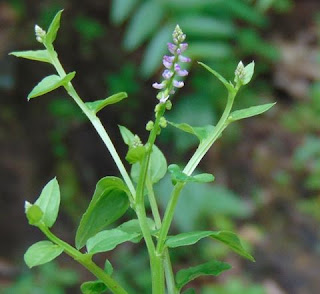Salomonia cantoniensis Lour.
Fam: Polygalaceae
Fam: Polygalaceae
Distribution: E, C, S & SW China; Bhutan, Cambodia, India, Indonesia, Laos, Malaysia, Myanmar, Nepal, Thailand, Vietnam,
Philippines, Australia.
Ecology: Forests on hillslopes. Flowering: Jul.–Aug.; fruiting: Aug.–Oct.
Uses: Medicinal (folklore).
Philippines, Australia.
Ecology: Forests on hillslopes. Flowering: Jul.–Aug.; fruiting: Aug.–Oct.
Uses: Medicinal (folklore).
Herbs annual, erect, 5-25 cm tall. Roots slender, fragrant. Stem thin, multibranched, 3-winged, glabrous. Petiole 1.5-2 mm; leaf blade ovate-cordate or cordate, 5-16 × 5-12 mm, membranous, glabrous, 3-veined, base cordate or truncate, margin entire or slightly undulate, apex obtuse, mucronate. Spike terminal, 1-6 cm, elongated after anthesis. Flowers very small, 2-3 mm, sessile; bracts caducous, very small.









